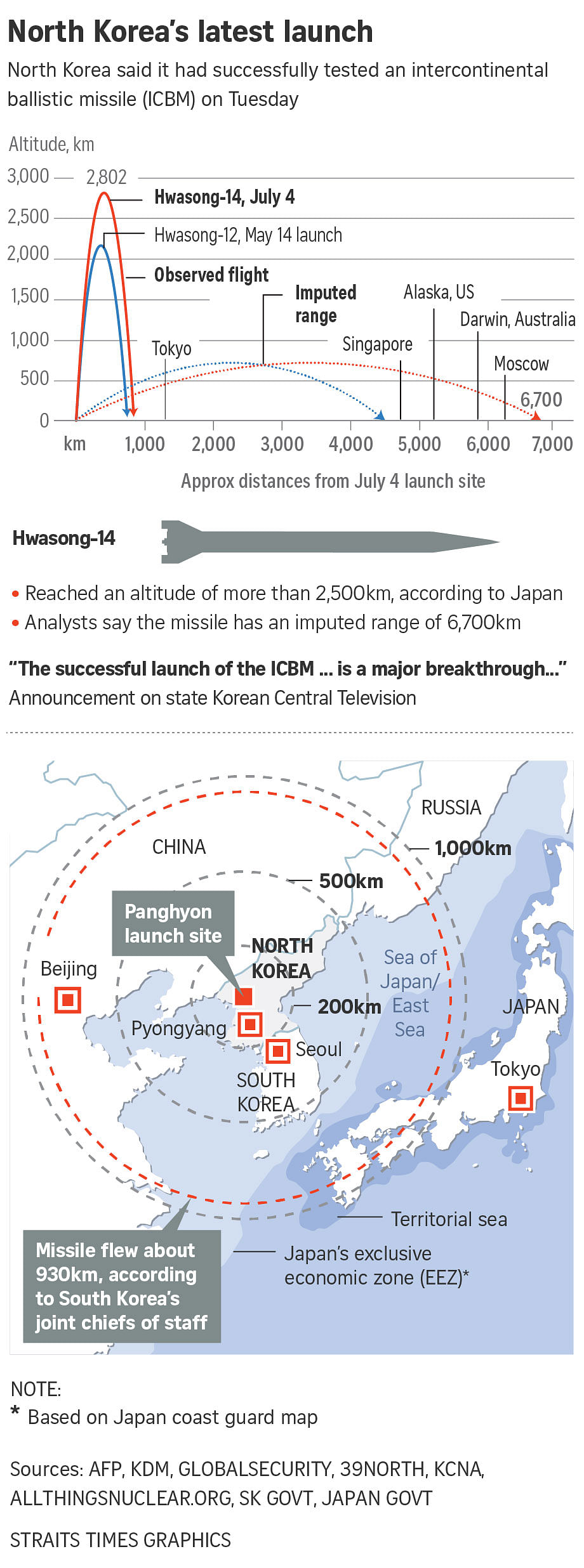SEOUL (REUTERS, AFP) - North Korea said it successfully tested a new intercontinental ballistic missile on Tuesday (July 4) which flew a trajectory that an expert said could allow a weapon to hit the US state of Alaska.
The launch came as the United States prepared to mark its Independence Day and triggered a Twitter outburst from US President Donald Trump who urged China to "end this nonsense once and for all".
The North has long sought to build a rocket capable of delivering an atomic warhead to the continental United States - something that Trump has vowed "won't happen". Its possession of a working ICBM will force a recalculation of the strategic threat it poses.
The "landmark" test of a Hwasong-14 missile was overseen by leader Kim Jong Un, an emotional female announcer said on state Korean Central Television. It reached an altitude of 2,802 kilometres and flew 933 kilometres, she added.
The North was "a strong nuclear power state" and had "a very powerful ICBM that can strike any place in the world" she said.
South Korea and Japan's militaries said the missile landing in Japan's Exclusive Economic Zone (EEZ).

The US Pacific Command said earlier Tuesday it detected and tracked the "single launch of a land-based, intermediate range ballistic missile" for 37 minutes near an airfield in Panghyon, about 100 km north-west of Pyongyang.
"We are working with our inter-agency partners on a more detailed assessment. We continue to monitor North Korea's actions closely. US Pacific Command stands behind our ironclad commitment to the security of our allies in the Republic of Korea and Japan," the statement added.
Trump urges China to 'put heavy move' on North
Stock markets in both South Korea and Japan fell after the missile launch, with the Kospi ending down 0.6 per cent and Japan's Nikkei share average ending down 0.1 per cent.
Japan's Prime Minister Shinzo Abe said on Tuesday he will ask the presidents of China and Russia to play more constructive roles in efforts to stop the Pyongyang's arms programme.
"Leaders of the world will gather at the G20 meeting. I would like to strongly call for solidarity of the international community on the North Korean issue," Abe told reporters. Japan said on Monday the United States, South Korea and Japan will have a trilateral summit on North Korea at the G20. China's leader Xi Jinping will also be at the July 7-8 meeting in Hamburg, Germany.
Trump, responding to the latest launch, wrote on Twitter: "North Korea has just launched another missile. Does this guy have anything better to do with his life?" an apparent reference to North Korean leader Kim Jong Un.
"Hard to believe South Korea and Japan will put up with this much longer. Perhaps China will put a heavy move on North Korea and end this nonsense once and for all!", Trump said in a series of tweets.
China's Foreign Ministry on Tuesday called for calm and restraint after the launch. Ministry spokesman Geng Shuang said United Nations Security Council resolutions had clear rules on North Korean missile launches and China is opposed to Pyongyang violating those rules.
He was speaking at a daily news briefing.
South Korean President Moon Jae In, who convened a national security council meeting, said the missile was believed to be an intermediate range type, but the military was also looking at the possibility it was an intercontinental ballistic missile (ICBM).
Alaska within range: Analysts
North Korea has been working to develop a nuclear-tipped ICBM capable of hitting the United States, ignoring repeated warnings from the international community.
David Wright, of the Union of Concerned Scientists, said the available figures implied a significant increase in the range of Pyongyang's missiles.
The missile would have had to have flown on a "very highly lofted trajectory" and reached a maximum altitude of more than 2,800km, he said. "If the reports are correct, that same missile could reach a maximum range of roughly 6,700km on a standard trajectory," he wrote on the organisation's allthingsnuclear blog.
"That range would not be enough to reach the lower 48 states or the large islands of Hawaii, but would allow it to reach all of Alaska."
The North's missile launch is the last since Pyongyang fired several cruise missiles in early June and comes ahead of the leaders of the United States, China, Japan and South Korea are expected to discuss efforts to rein in the North's nuclear and missile tests the G-20 summit on July 7 to 8.
Earlier this week, North Korea was a key topic in phone calls between Trump and the leaders of China and Japan. Leaders of both Asian countries reaffirmed their commitment to a denuclearised Korean Peninsula.
Last week after his first summit with Moon, Trump called for a determined response to North Korea, stressing the importance of the alliance between the two countries.
Crisis could 'get out of control': China
Hours before the missile launch, China's UN ambassador Liu Jieyi warned of "disastrous" consequences if world powers fail to find a way to ease tensions with North Korea which he said could "get out of control".
"Currently tensions are high and we certainly would like to see a de-escalation," Liu told a news conference at UN headquarters on Monday as China takes over the Security Council presidency in July.
"If tension only goes up... then sooner or later it will get out of control and the consequences would be disastrous," he said.

